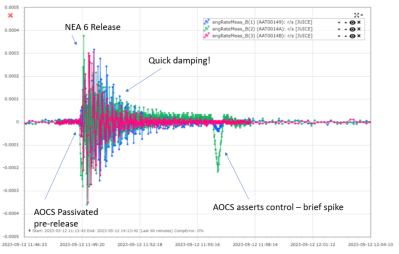It turns out that whacking busted things to fix them works as well on Mars as it does on Earth, as NASA managed to fix its wonky “mole” with a little help from the InSight lander’s robotic arm. Calling it “percussive maintenance” is perhaps a touch overwrought; as we explained last week, NASA prepped carefully for this last-ditch effort to salvage the HP³ experiment, and it was really more of a gentle nudge that a solid smack with the spacecraft’s backhoe bucket. From the before and after pictures, it still looks like the mole is a little off-kilter, and there was talk that the shovel fix was only the first step in a more involved repair. We’ll keep an ear open for more details — this kind of stuff is fascinating, and beats the news from Earth these days by a long shot.
Of course, the COVID-19 pandemic news isn’t all bad. Yes, the death toll is rising, the number of cases is still growing exponentially, and billions of people are living in fear and isolation. But ironically, we’re getting good at community again, and the hacker community is no exception. People really want to pitch in and do something to help, and we’ve put together some resources to help. Check out our Hackaday How You Can Help spreadsheet, a comprehensive list of what efforts are currently looking for help, plus what’s out there in terms of Discord and Slack channels, lists of materials you might need if you choose to volunteer to build something, and even a list of recent COVID-19 Hackaday articles if you need inspiration. You’ll also want to check out our calendar of free events and classes, which might be a great way to use the isolation time to better your lot.
Individual hackers aren’t the only ones pitching in, of course. Maybe of the companies in the hacker and maker space are doing what they can to help, too. Ponoko is offering heavy discounts for hardware startups to help them survive the current economic pinch. They’ve also enlisted other companies, like Adafruit and PCBWay, to join with them in offering similar breaks to certain customers.
More good news from the fight against COVID-19. Folding@Home, the distributed computing network that is currently working on folding models from many of the SARS-CoV-2 virus proteins, has broken the exaFLOP barrier and is now the most powerful computer ever built. True, not every core is active at any given time, but the 4.6 million cores and 400,000-plus GPUs in the network pushed it over from the petaFLOP range of computers like IBM’s Summit, until recently the most powerful supercomputer ever built. Also good news is that Team Hackaday is forming a large chunk of the soul of this new machine, with 3,900 users and almost a million work units completed. Got an old machine around? Read Mike Sczcys’ article on getting started and join Team Hackaday.
And finally, just because we all need a little joy in our lives right now, and because many of you are going through sports withdrawal, we present what could prove to be the new spectator sports sensation: marble racing. Longtime readers will no doubt recognize the mad genius of Martin and his Marble Machine X, the magnificent marble-dropping music machine that’s intended as a follow-up to the original Marble Machine. It’s also a great racetrack, and Martin does an amazing job doing both the color and turn-by-turn commentary in the mock race. It’s hugely entertaining, and a great tour of the 15,000-piece contraption. And when you’re done with the race, it’s nice to go back to listen to the original Marble Machine tune — it’s a happy little song for these trying times.















